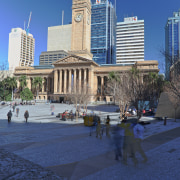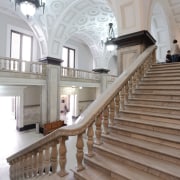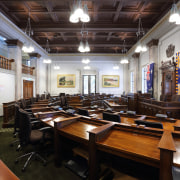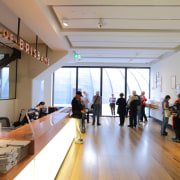Heritage restoration underpinned by code-compliant functionality, and with a new museum on top Brisbane City Hall is again a showpiece for the Queensland capital
Tanner Kibble Denton Architects (TKD) and GHD, as architects in association, formed TannerGHD for the resoration and update of the historic Brisbane City Hall

Introducing contemporary functionality to an older building is one thing. Doing so seamlessly while retaining a heritage fabric is quite another.
Built in the 1920s in the Classical Revival style, the Brisbane City Hall is a gracious urban landmark and focus of civic pride. Its 10-storey tower was the tallest structure in the inner city until the 1960s.
In 2008, Brisbane City Council recognised that the heritage building needed to be restored to its original grandeur, and at the same time brought up to speed in terms of functionality and code compliance. Subsidence and water ingress had compromised its structural integrity, and fire detection and control systems were inadequate. Adding to the mix, earlier refits, which included faux heritage detailing, mezzanines and services, had detracted from the building's functionality, with service plant obstructing lightwells, and dropped ceilings obscuring original features.
Tanner Kibble Denton Architects (TKD) and GHD, as architects in association, formed TannerGHD for the restoration, which began in 2009. TKD led the design team, with GHD providing support in relationship and contract management, interior design, architectural drafting, risk management and safety in design.
Project leader for TKD, architect Megan Jones, says there were many aspects to the project, from the restoration and updating of the hall's facilities to the seamless insertion of a kitchen and the new Museum of Brisbane on the roof.
"The rejuvenation of the entry foyers, circulation spaces and public amenities was one important focus. Work included cleaning and restoring the white marble floors, mosaic tilework, oak joinery, and bronzed coffered ceilings. Existing stairs, lifts and bathrooms were refurbished and new facilities introduced. The second floor circular corridor, which was clogged with service plant from earlier refits, was rescued and reconfigured."
Upgrading to new code-compliant facilities was essential. To meet modern fire code requirements, for example, several sophisticated, near-invisible approaches were introduced.
"We used fire-retardant intumescent paint to help protect the original, rather weak, structural concrete, while a misting system provides fire protection to significant spaces," says Jones. "This robs a fire of oxygen and avoids the need for ceiling-height sprinklers, which would have been difficult to install and would have looked at odds with the historic arched ceilings. And in the event of fire, ceiling sprinklers in full flow would cause costly water damage to the protected building."
Other measures included a sympathetic upgrade of the original glazed doors for fire separation, together with new fire-rated glazed timber doors.
"At the centre of the refit was the three-level auditorium the circular heart of the rectilinear building. This has been reworked to improve its function, comfort and capacity, while respecting the original architecture and fabric."
Work here included removing the stage entirely, excavating beneath it, and inserting a commercial kitchen. The stage was then strengthened and restored, making it suitable for a much wider range of performances. New acoustic panels and blinds were set around the perimeter of the auditorium, integrated into the original geometry with new architectural elements of bronze mesh and timber trellis panels. The space can now be tuned to suit any type of performance. The historic organ, older than the hall itself, has also been refurbished.
The auditorium's new tensile fabric ceiling is its crowning glory in terms of aesthetics and efficiency. This further aids the acoustics, provides a dramatic focus through its twinkling LED lighting, and is also part of the invisible smoke exhaust system.
A new colour scheme based on the original design overlays and enriches the entire space.
The upgrade to the 80-year-old building has also provided a contemporary workplace for the mayor, deputy mayor, councillors and their staff as well as the staff of the Museum of Brisbane. The civic offices are co-located with function rooms, meeting rooms and catering facilities used by the council for conferences, training and public meetings.
Each of the 12 function rooms has been equipped for multipurpose events, complete with pantry areas and audiovisual and information technology facilities. Local, discreet dropped acoustic ceiling panels hide services, while revealing decorative plaster cornices. Three function rooms have access through French doors to the new landscaped courtyards set within original light wells.
Together with the total refurbishment and upgrading of the heritage building comes the insertion of the new addition at roof level. The Museum of Brisbane is built in behind the existing parapets and comprises a steel structure with a lightweight floor, walls and roofing.
The museum includes two large galleries and several smaller galleries and theatres linked and integrated with the existing roof pavilions. One long gallery runs the length of the building. The reception and breakout spaces have views of the copper-clad dome of the auditorium, while the concrete-and-steel structural support for the clock tower forms part of the museum's interiors. There are also back-of-house facilities for conservation and preparation of exhibitions, says Jones.
"The Brisbane City Hall restoration shows that major structural, fire and acoustics and access upgrades can be integrated into a heritage building in a way that balances respect for the quality of the original design with the architectural expectations of contemporary interiors. And that includes the additional amenities, from the commercial kitchen to the new Museum of Brisbane."
Credit list
Project
Building contractors
Statutory planners
Electrical and mechanical services engineers
ESD
BCA consultant and certifier
Catering kitchen designers
Paints
Windows
Blinds
Furniture restoration
Architect
Quantity surveyors
Structural and civil engineers
Hydraulic services engineers
Acoustic consultants
Access consultant
Flooring
Specialist plastering
Locksmiths
Secondary glazing
Story by: Charles Moxham
Home kitchen bathroom commercial design
Connected to the ocean
Masculine meets mixed use
Contrast and connection
Commercial Design Trends Vol. 31/3
Commercial Design Trends is aimed at our professional readers, and showcases commercial buildings. The book features reg...
Read More














